翻译目的论在跨文化翻译中的应用
- 格式:pdf
- 大小:170.06 KB
- 文档页数:4

目的论及其在英汉互译中的应用在英汉互译中,目的论的重要性不言而喻。
本文将概述目的论的基本概念、优缺点,并探讨目的论在英汉互译中的应用。
目的论是一种翻译理论,它强调翻译的目的决定翻译的行为。
目的论有三大原则:目的原则、连贯原则和忠实原则。
目的原则指的是翻译的目的决定翻译策略;连贯原则是指翻译后的文本应符合目标语言的表达习惯;忠实原则指原文和译文之间应存在连贯性。
目的论的优点在于它突出了翻译的目的性,缺点在于它可能忽视原文作者意图。
在英汉互译中,首先需要理解原文作者的意图和目的。
这可以通过分析原文的语境、文体和语义来实现。
例如,在翻译一篇新闻报道时,译者需要了解新闻报道的写作目的是传达信息,因此翻译时应力求准确、客观。
确立自己的翻译目的,从而更好地传达原文意思理解原文的目的是为了确立自己的翻译目的。
在英汉互译中,译者应根据自己的翻译目的,选择适当的翻译策略。
例如,如果翻译的目的是为学术研究提供资料,那么译者需要尽可能保留原文的信息和语言特征;如果翻译的目的是为娱乐读者,那么译者可能需要注重译文的流畅性和生动性。
在确立翻译目的后,译者需要根据不同的翻译目的选择合适的翻译方法。
例如,如果翻译的目的是为了传达原文的形式和内容,那么译者可以选择直译的方法;如果翻译的目的是为了使译文符合目标语言的表达习惯,那么译者可以选择意译的方法。
在翻译实践中,目的论可以帮助译者提高翻译精度。
译者可以根据目的原则,判断哪些翻译策略是必要的,哪些是不必要的。
例如,在翻译科技文献时,译者需要注重术语的准确性和语言的规范性;在翻译广告时,译者需要注重语言的生动性和感染力。
通过运用目的论指导翻译实践,译者可以更好地实现翻译的目的,提高翻译精度。
目的论在英汉互译中具有重要的应用价值。
通过理解原文的目的和意图,确立自己的翻译目的,选择合适的翻译方法和运用目的论指导翻译实践,译者可以更好地实现翻译的目的,提高翻译精度。
因此,目的论是英汉互译中不可或缺的理论指导。
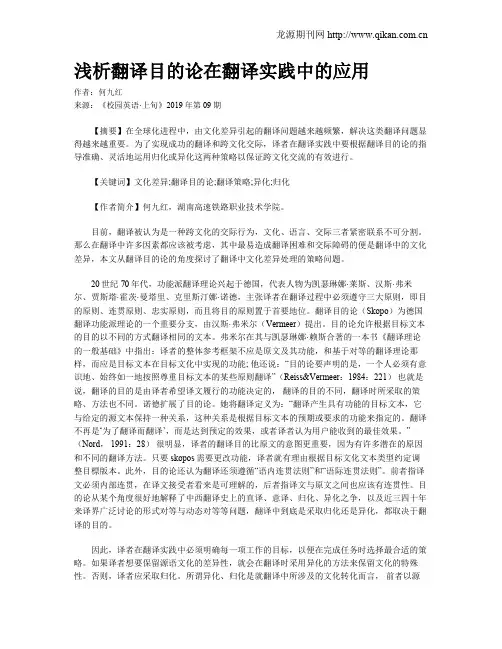
浅析翻译目的论在翻译实践中的应用作者:何九红来源:《校园英语·上旬》2019年第09期【摘要】在全球化进程中,由文化差异引起的翻译问题越来越频繁,解决这类翻译问题显得越来越重要。
为了实现成功的翻译和跨文化交际,译者在翻译实践中要根据翻译目的论的指导准确、灵活地运用归化或异化这两种策略以保证跨文化交流的有效进行。
【关键词】文化差异;翻译目的论;翻译策略;异化;归化【作者简介】何九红,湖南高速铁路职业技术学院。
目前,翻译被认为是一种跨文化的交际行为,文化、语言、交际三者紧密联系不可分割。
那么在翻译中许多因素都应该被考虑,其中最易造成翻译困难和交际障碍的便是翻译中的文化差异,本文从翻译目的论的角度探讨了翻译中文化差异处理的策略问题。
20世纪70年代,功能派翻译理论兴起于德国,代表人物为凯瑟琳娜·莱斯、汉斯·弗米尔、贾斯塔·霍茨·曼塔里、克里斯汀娜·诺德,主张译者在翻译过程中必须遵守三大原则,即目的原则、连贯原则、忠实原则,而且将目的原则置于首要地位。
翻译目的论(Skopo)为德国翻译功能派理论的一个重要分支,由汉斯·弗米尔(Vermeer)提出。
目的论允许根据目标文本的目的以不同的方式翻译相同的文本。
弗米尔在其与凯瑟琳娜·赖斯合著的一本书《翻译理论的一般基础》中指出:译者的整体参考框架不应是原文及其功能,和基于对等的翻译理论那样,而应是目标文本在目标文化中实现的功能; 他还说:“目的论要声明的是,一个人必须有意识地、始终如一地按照尊重目标文本的某些原则翻译”(Reiss&Vermeer:1984:221)也就是说,翻译的目的是由译者希望译文履行的功能决定的,翻译的目的不同,翻译时所采取的策略、方法也不同。
诺德扩展了目的论。
她将翻译定义为:“翻译产生具有功能的目标文本,它与给定的源文本保持一种关系,这种关系是根据目标文本的预期或要求的功能来指定的。
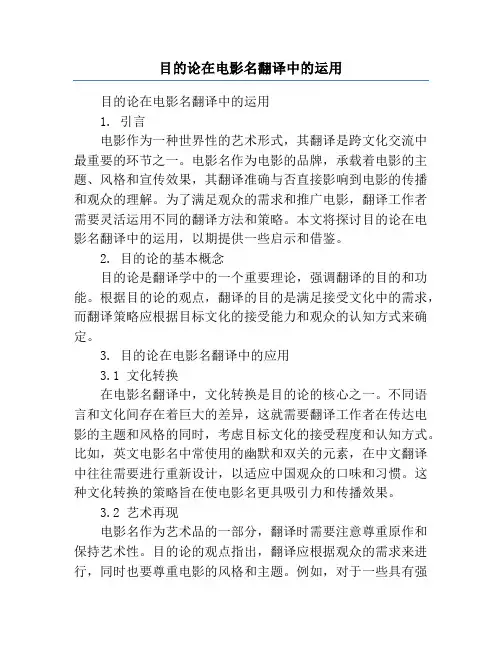
目的论在电影名翻译中的运用目的论在电影名翻译中的运用1. 引言电影作为一种世界性的艺术形式,其翻译是跨文化交流中最重要的环节之一。
电影名作为电影的品牌,承载着电影的主题、风格和宣传效果,其翻译准确与否直接影响到电影的传播和观众的理解。
为了满足观众的需求和推广电影,翻译工作者需要灵活运用不同的翻译方法和策略。
本文将探讨目的论在电影名翻译中的运用,以期提供一些启示和借鉴。
2. 目的论的基本概念目的论是翻译学中的一个重要理论,强调翻译的目的和功能。
根据目的论的观点,翻译的目的是满足接受文化中的需求,而翻译策略应根据目标文化的接受能力和观众的认知方式来确定。
3. 目的论在电影名翻译中的应用3.1 文化转换在电影名翻译中,文化转换是目的论的核心之一。
不同语言和文化间存在着巨大的差异,这就需要翻译工作者在传达电影的主题和风格的同时,考虑目标文化的接受程度和认知方式。
比如,英文电影名中常使用的幽默和双关的元素,在中文翻译中往往需要进行重新设计,以适应中国观众的口味和习惯。
这种文化转换的策略旨在使电影名更具吸引力和传播效果。
3.2 艺术再现电影名作为艺术品的一部分,翻译时需要注意尊重原作和保持艺术性。
目的论的观点指出,翻译应根据观众的需求来进行,同时也要尊重电影的风格和主题。
例如,对于一些具有强烈艺术气息的电影,翻译时可以采用意译的方式,以保留原作的独特性和美感。
3.3 市场推广电影名翻译还需要考虑市场推广的目的和效果。
不同的电影类型和受众群体对于电影名的要求不同,因此翻译工作者需要根据目标市场的需求来进行翻译。
一些商业片的电影名可能更注重吸引眼球和提升观众的期待,而一些艺术片则更注重传达电影的主题和情感。
4. 目的论在电影名翻译中的挑战和解决方法4.1 语言差异不同语言间存在着语法、简繁体字、表达方式等方面的差异,这给电影名的翻译带来了挑战。
为了克服这些困难,翻译工作者需要熟悉目标语言和文化,并运用目的论的原则进行适当调整和转换。
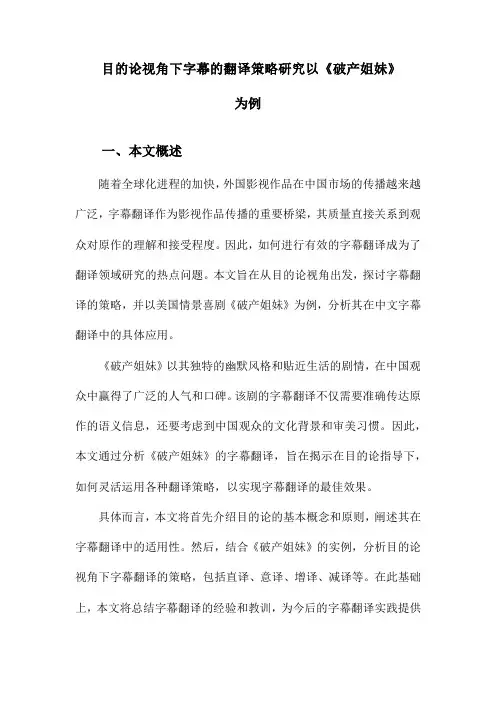
目的论视角下字幕的翻译策略研究以《破产姐妹》为例一、本文概述随着全球化进程的加快,外国影视作品在中国市场的传播越来越广泛,字幕翻译作为影视作品传播的重要桥梁,其质量直接关系到观众对原作的理解和接受程度。
因此,如何进行有效的字幕翻译成为了翻译领域研究的热点问题。
本文旨在从目的论视角出发,探讨字幕翻译的策略,并以美国情景喜剧《破产姐妹》为例,分析其在中文字幕翻译中的具体应用。
《破产姐妹》以其独特的幽默风格和贴近生活的剧情,在中国观众中赢得了广泛的人气和口碑。
该剧的字幕翻译不仅需要准确传达原作的语义信息,还要考虑到中国观众的文化背景和审美习惯。
因此,本文通过分析《破产姐妹》的字幕翻译,旨在揭示在目的论指导下,如何灵活运用各种翻译策略,以实现字幕翻译的最佳效果。
具体而言,本文将首先介绍目的论的基本概念和原则,阐述其在字幕翻译中的适用性。
然后,结合《破产姐妹》的实例,分析目的论视角下字幕翻译的策略,包括直译、意译、增译、减译等。
在此基础上,本文将总结字幕翻译的经验和教训,为今后的字幕翻译实践提供有益的参考。
二、理论框架:目的论概述在翻译理论中,目的论(Skopostheorie)是一种重要的理论框架,由德国翻译理论家汉斯·弗米尔(Hans Vermeer)和凯瑟琳娜·莱斯(Katharina Reiss)于20世纪70年代提出。
目的论强调翻译行为的目的性,认为翻译是一种有意图的人类行为,其首要原则是翻译行为所要达到的目的决定整个翻译过程,即结果决定方法。
这一理论突破了传统等值翻译理论的束缚,将翻译研究的重点从原文和译文的对等关系转向翻译行为的目的和效果。
在目的论中,翻译被视为一种跨文化交际活动,其最终目的是实现译文在目标语文化中的交际功能。
因此,翻译策略和方法的选择应根据翻译的目的和译文读者的需求来确定。
在目的论的指导下,译者具有更大的灵活性和自主权,可以根据实际情况调整翻译策略,以实现翻译目的。
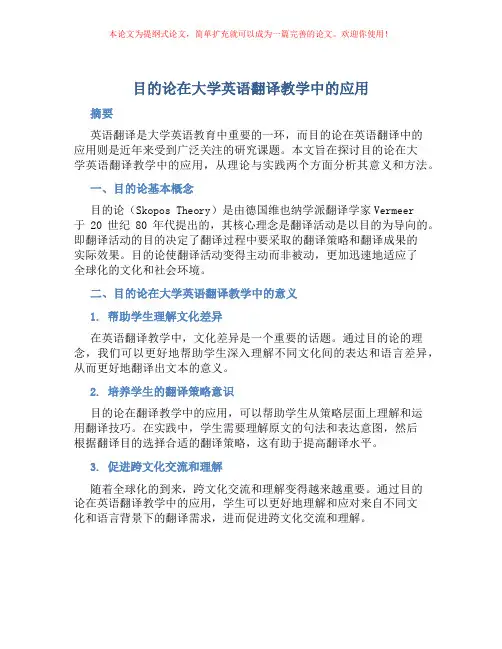
目的论在大学英语翻译教学中的应用摘要英语翻译是大学英语教育中重要的一环,而目的论在英语翻译中的应用则是近年来受到广泛关注的研究课题。
本文旨在探讨目的论在大学英语翻译教学中的应用,从理论与实践两个方面分析其意义和方法。
一、目的论基本概念目的论(Skopos Theory)是由德国维也纳学派翻译学家Vermeer于20世纪80年代提出的,其核心理念是翻译活动是以目的为导向的。
即翻译活动的目的决定了翻译过程中要采取的翻译策略和翻译成果的实际效果。
目的论使翻译活动变得主动而非被动,更加迅速地适应了全球化的文化和社会环境。
二、目的论在大学英语翻译教学中的意义1. 帮助学生理解文化差异在英语翻译教学中,文化差异是一个重要的话题。
通过目的论的理念,我们可以更好地帮助学生深入理解不同文化间的表达和语言差异,从而更好地翻译出文本的意义。
2. 培养学生的翻译策略意识目的论在翻译教学中的应用,可以帮助学生从策略层面上理解和运用翻译技巧。
在实践中,学生需要理解原文的句法和表达意图,然后根据翻译目的选择合适的翻译策略,这有助于提高翻译水平。
3. 促进跨文化交流和理解随着全球化的到来,跨文化交流和理解变得越来越重要。
通过目的论在英语翻译教学中的应用,学生可以更好地理解和应对来自不同文化和语言背景下的翻译需求,进而促进跨文化交流和理解。
三、目的论在大学英语翻译教学中的实践1. 教师角色的重要性在目的论的应用下,教师不再是传授知识的单一角色,而是要担起引导学生理解翻译目的、进行翻译策略分析和评估的角色,要注重激发学生的翻译策略意识和跨文化理解能力。
2. 实例操练的必要性在实践中,通过教师设置一定的实例来操练,可以帮助学生更好地领悟目的论的理念,比如设定不同翻译目的和任务,鼓励学生运用目的论理念构思翻译策略,并在教师的引导下进行分析和评估。
3. 辅助工具的使用目的论在翻译教学中的应用辅助工具的使用是不可或缺的,利用相关的软件和网络技术可以更好地辅助翻译理论的学习和身处不同文化和语言上下文中的实践。

浅析翻译目的论三原则及其在翻译实践中的应用一、概述翻译目的论,作为一种重要的翻译理论,起源于20世纪70年代的德国,由汉斯弗米尔(Hans J. Vermeer)提出,并由其学生克里斯蒂娜诺德(Christiane Nord)进一步发展和完善。
翻译目的论强调翻译行为的目的性,认为翻译是一种有目的的跨文化交际活动,其首要原则是翻译行为所要达到的目的决定整个翻译过程。
这一理论突破了传统等值理论的束缚,为翻译研究和实践提供了新的视角。
翻译目的论提出了三大原则:目的原则、连贯原则和忠实原则。
目的原则是指翻译行为所要达到的目的决定整个翻译过程,即翻译的方法与策略必须服务于翻译的目的。
连贯原则要求译文必须符合语内连贯的标准,即译文具有可读性和可接受性,能够使接受者理解并在译入语文化及使用译文的交际语境中有意义。
忠实原则是指原文与译文之间应该存在语际连贯一致。
这三大原则在翻译实践中具有指导意义,能够帮助译者根据不同的翻译目的选择合适的翻译策略和方法。
本文将对翻译目的论的三大原则进行浅析,并探讨它们在翻译实践中的应用。
通过具体案例分析,展示如何根据不同的翻译目的,灵活运用这些原则,以实现有效的跨文化交际。
同时,本文还将对翻译目的论在翻译实践中的意义进行探讨,以期对翻译实践和研究提供有益的启示。
1. 翻译目的论概述翻译目的论,作为一种重要的翻译理论,起源于20世纪70年代的德国功能主义翻译理论。
该理论主张翻译活动应以实现特定的翻译目的为核心,强调翻译过程中译者的主观能动性和译文的预期功能。
翻译目的论突破了传统等值翻译理论的束缚,提出了以翻译目的为导向的翻译原则和方法。
在翻译目的论中,翻译被视为一种有目的的跨语言、跨文化的交际行为。
翻译的目的可能因文本的不同而有所不同,如信息传递、文化交流、商业推广等。
翻译过程中,译者应根据翻译目的选择合适的翻译策略和方法,以确保译文能够有效地实现预期的交际功能。
翻译目的论提出了三个基本原则,即目的原则、连贯性原则和忠实性原则。
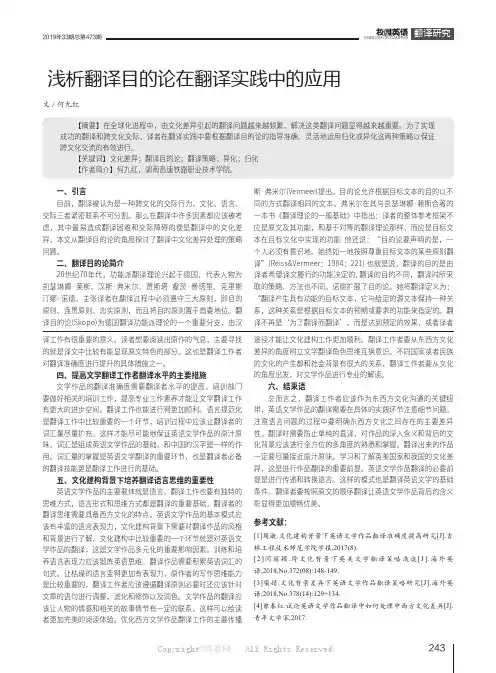
2019年33期总第473期ENGLISH ON CAMPUS浅析翻译目的论在翻译实践中的应用文/何九红一、引言目前,翻译被认为是一种跨文化的交际行为,文化、语言、交际三者紧密联系不可分割。
那么在翻译中许多因素都应该被考虑,其中最易造成翻译困难和交际障碍的便是翻译中的文化差异,本文从翻译目的论的角度探讨了翻译中文化差异处理的策略问题。
二、翻译目的论简介20世纪70年代,功能派翻译理论兴起于德国,代表人物为凯瑟琳娜·莱斯、汉斯·弗米尔、贾斯塔·霍茨·曼塔里、克里斯汀娜·诺德,主张译者在翻译过程中必须遵守三大原则,即目的原则、连贯原则、忠实原则,而且将目的原则置于首要地位。
翻译目的论(Skopo)为德国翻译功能派理论的一个重要分支,由汉斯·弗米尔(Vermeer)提出。
目的论允许根据目标文本的目的以不同的方式翻译相同的文本。
弗米尔在其与凯瑟琳娜·赖斯合著的一本书《翻译理论的一般基础》中指出:译者的整体参考框架不应是原文及其功能,和基于对等的翻译理论那样,而应是目标文本在目标文化中实现的功能 他还说:“目的论要声明的是,一个人必须有意识地、始终如一地按照尊重目标文本的某些原则翻译”(Reiss&Vermeer:1984:221) 也就是说,翻译的目的是由译者希望译文履行的功能决定的, 翻译的目的不同,翻译时所采取的策略、方法也不同。
诺德扩展了目的论。
她将翻译定义为:“翻译产生具有功能的目标文本,它与给定的源文本保持一种关系,这种关系是根据目标文本的预期或要求的功能来指定的。
翻译不再是‘为了翻译而翻译’,而是达到预定的效果,或者译者【摘要】在全球化进程中,由文化差异引起的翻译问题越来越频繁,解决这类翻译问题显得越来越重要。
为了实现成功的翻译和跨文化交际,译者在翻译实践中要根据翻译目的论的指导准确、灵活地运用归化或异化这两种策略以保证跨文化交流的有效进行。
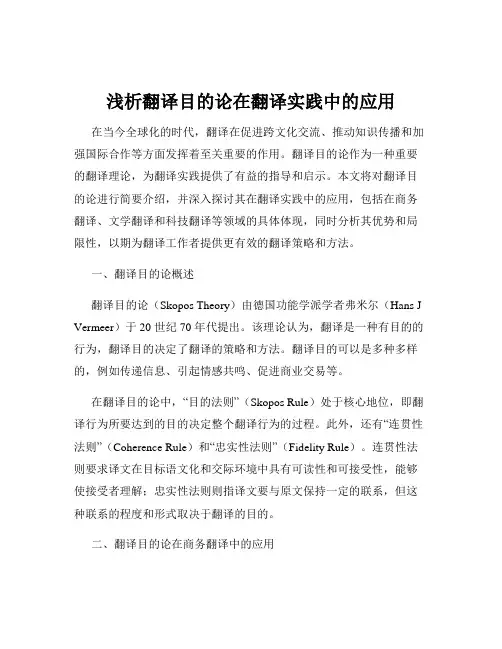
浅析翻译目的论在翻译实践中的应用在当今全球化的时代,翻译在促进跨文化交流、推动知识传播和加强国际合作等方面发挥着至关重要的作用。
翻译目的论作为一种重要的翻译理论,为翻译实践提供了有益的指导和启示。
本文将对翻译目的论进行简要介绍,并深入探讨其在翻译实践中的应用,包括在商务翻译、文学翻译和科技翻译等领域的具体体现,同时分析其优势和局限性,以期为翻译工作者提供更有效的翻译策略和方法。
一、翻译目的论概述翻译目的论(Skopos Theory)由德国功能学派学者弗米尔(Hans J Vermeer)于 20 世纪 70 年代提出。
该理论认为,翻译是一种有目的的行为,翻译目的决定了翻译的策略和方法。
翻译目的可以是多种多样的,例如传递信息、引起情感共鸣、促进商业交易等。
在翻译目的论中,“目的法则”(Skopos Rule)处于核心地位,即翻译行为所要达到的目的决定整个翻译行为的过程。
此外,还有“连贯性法则”(Coherence Rule)和“忠实性法则”(Fidelity Rule)。
连贯性法则要求译文在目标语文化和交际环境中具有可读性和可接受性,能够使接受者理解;忠实性法则则指译文要与原文保持一定的联系,但这种联系的程度和形式取决于翻译的目的。
二、翻译目的论在商务翻译中的应用商务翻译涉及合同、商务信函、产品说明书等多种文本类型,其目的通常是为了促进商务活动的顺利进行和达成交易。
在商务翻译中,翻译目的论的应用主要体现在以下几个方面:1、术语的准确翻译商务领域有大量的专业术语,准确翻译这些术语对于传达准确的商务信息至关重要。
翻译目的决定了术语翻译的方法。
例如,如果翻译的目的是为了让目标读者快速理解文本的主要内容,对于一些复杂的术语可以采用意译的方法,用通俗易懂的语言进行解释;如果是为了保持法律文件的严谨性和权威性,则可能需要采用直译或音译加注释的方法,以确保术语的准确性和专业性。
2、文化适应不同国家和地区在商务文化方面存在差异。
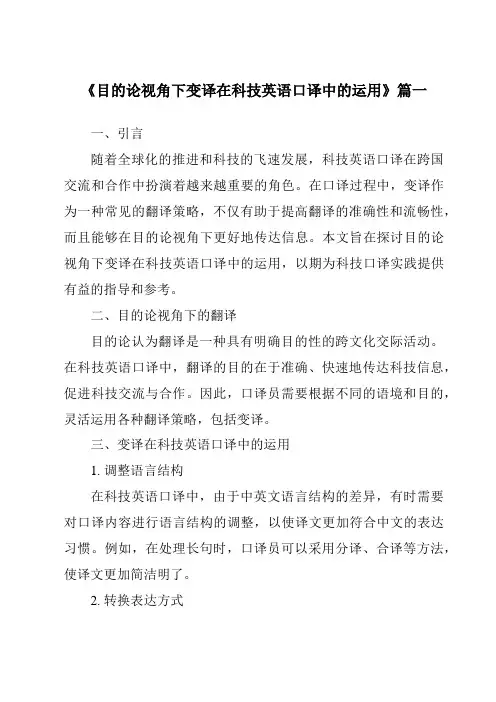
《目的论视角下变译在科技英语口译中的运用》篇一一、引言随着全球化的推进和科技的飞速发展,科技英语口译在跨国交流和合作中扮演着越来越重要的角色。
在口译过程中,变译作为一种常见的翻译策略,不仅有助于提高翻译的准确性和流畅性,而且能够在目的论视角下更好地传达信息。
本文旨在探讨目的论视角下变译在科技英语口译中的运用,以期为科技口译实践提供有益的指导和参考。
二、目的论视角下的翻译目的论认为翻译是一种具有明确目的性的跨文化交际活动。
在科技英语口译中,翻译的目的在于准确、快速地传达科技信息,促进科技交流与合作。
因此,口译员需要根据不同的语境和目的,灵活运用各种翻译策略,包括变译。
三、变译在科技英语口译中的运用1. 调整语言结构在科技英语口译中,由于中英文语言结构的差异,有时需要对口译内容进行语言结构的调整,以使译文更加符合中文的表达习惯。
例如,在处理长句时,口译员可以采用分译、合译等方法,使译文更加简洁明了。
2. 转换表达方式在科技英语口译中,有些科技术语或专业表达在中文中并没有完全对应的词汇。
此时,口译员需要采用意译、音译加释意等变译方法,使译文更加贴近中文表达习惯。
例如,对于一些英文缩写或专业术语,可以采用音译加释意的方式,使听众更容易理解。
3. 补充背景信息在科技英语口译中,由于文化背景和知识背景的差异,有时需要对原文信息进行补充和解释,以帮助听众更好地理解。
例如,在介绍某项科技产品时,口译员可以补充产品的研发背景、应用领域等信息,使听众更加全面地了解产品。
四、案例分析以某次国际科技会议为例,会议中涉及到了许多科技术语和专业表达。
口译员在翻译过程中采用了变译策略,如将长句分译、合译,将某些英文缩写或专业术语音译加释意等。
同时,为了帮助听众更好地理解会议内容,口译员还补充了相关背景信息。
这些变译策略的运用使得翻译更加准确、流畅,有效促进了会议的交流与合作。
五、结论在科技英语口译中,目的论视角下的变译具有重要的实践意义。
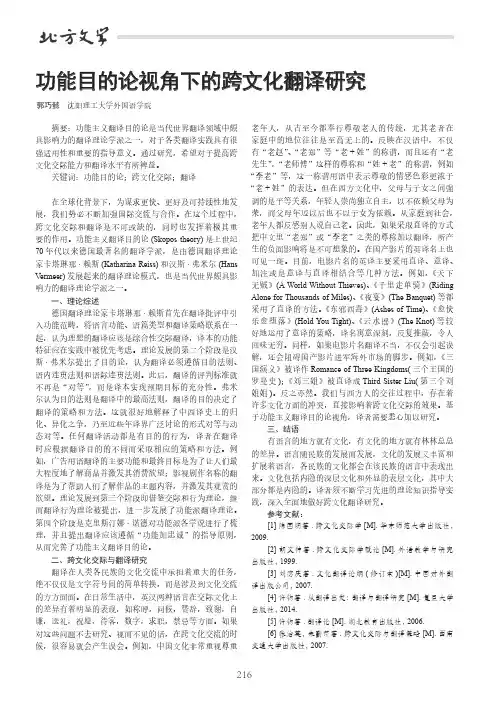
216功能目的论视角下的跨文化翻译研究郭巧懿 沈阳理工大学外国语学院摘要:功能主义翻译目的论是当代世界翻译领域中颇具影响力的翻译理论学派之一,对于各类翻译实践具有很强适用性和重要的指导意义。
通过研究,希望对于提高跨文化交际能力和翻译水平有所裨益。
关键词:功能目的论;跨文化交际;翻译在全球化背景下,为谋求更快、更好及可持续性地发展,我们势必不断加强国际交流与合作。
在这个过程中,跨文化交际和翻译是不可或缺的,同时也发挥着极其重要的作用。
功能主义翻译目的论(Skopos theory)是上世纪70年代以来德国最著名的翻译学派,是由德国翻译理论家卡塔琳那·赖斯(Katharina Reiss)和汉斯·弗米尔(Hans Vermeer)发展起来的翻译理论模式,也是当代世界颇具影响力的翻译理论学派之一。
一、理论综述德国翻译理论家卡塔琳那·赖斯首先在翻译批评中引入功能范畴,将语言功能、语篇类型和翻译策略联系在一起,认为理想的翻译应该是综合性交际翻译,译本的功能特征应在实践中被优先考虑。
理论发展的第二个阶段是汉斯·弗米尔提出了目的论,认为翻译必须遵循目的法则、语内连贯法则和语际连贯法则。
此后,翻译的评判标准就不再是“对等”,而是译本实现预期目标的充分性。
弗米尔认为目的法则是翻译中的最高法则,翻译的目的决定了翻译的策略和方法。
这就很好地解释了中西译史上的归化、异化之争,乃至近些年译界广泛讨论的形式对等与动态对等。
任何翻译活动都是有目的的行为,译者在翻译时应根据翻译目的的不同而采取相应的策略和方法。
例如,广告用语翻译的主要功能和最终目标是为了让人们最大程度地了解商品并激发其消费欲望;影视剧作名称的翻译是为了帮助人们了解作品的主题内容,并激发其观赏的欲望。
理论发展到第三个阶段即借鉴交际和行为理论,继而翻译行为理论被提出,进一步发展了功能派翻译理论。
第四个阶段是克里斯汀娜·诺德对功能派各学说进行了梳理,并且提出翻译应该遵循“功能加忠诚”的指导原则,从而完善了功能主义翻译目的论。
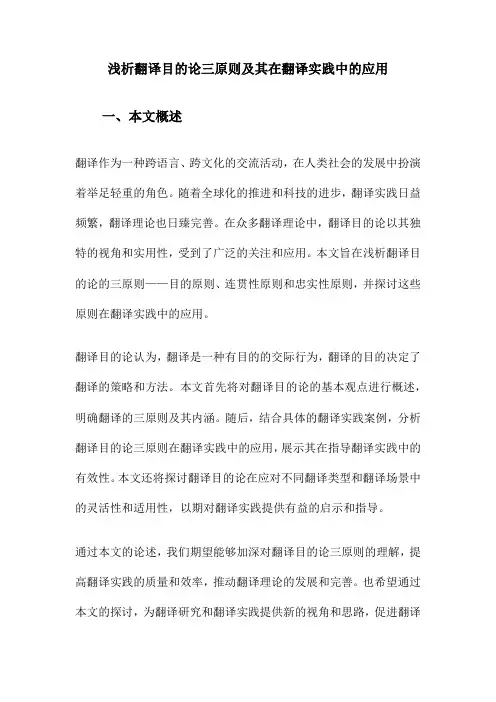
浅析翻译目的论三原则及其在翻译实践中的应用一、本文概述翻译作为一种跨语言、跨文化的交流活动,在人类社会的发展中扮演着举足轻重的角色。
随着全球化的推进和科技的进步,翻译实践日益频繁,翻译理论也日臻完善。
在众多翻译理论中,翻译目的论以其独特的视角和实用性,受到了广泛的关注和应用。
本文旨在浅析翻译目的论的三原则——目的原则、连贯性原则和忠实性原则,并探讨这些原则在翻译实践中的应用。
翻译目的论认为,翻译是一种有目的的交际行为,翻译的目的决定了翻译的策略和方法。
本文首先将对翻译目的论的基本观点进行概述,明确翻译的三原则及其内涵。
随后,结合具体的翻译实践案例,分析翻译目的论三原则在翻译实践中的应用,展示其在指导翻译实践中的有效性。
本文还将探讨翻译目的论在应对不同翻译类型和翻译场景中的灵活性和适用性,以期对翻译实践提供有益的启示和指导。
通过本文的论述,我们期望能够加深对翻译目的论三原则的理解,提高翻译实践的质量和效率,推动翻译理论的发展和完善。
也希望通过本文的探讨,为翻译研究和翻译实践提供新的视角和思路,促进翻译学科的繁荣和发展。
二、翻译目的论三原则解析翻译目的论是德国功能翻译理论的核心,它提出了三大原则来指导翻译实践,即目的原则、连贯性原则和忠实性原则。
这三大原则在翻译过程中各自扮演着重要的角色,共同确保了翻译的质量和效果。
目的原则是翻译目的论的首要原则。
它强调翻译行为所要达到的目的决定整个翻译过程的主要方式,即结果决定方法。
在翻译实践中,译者应根据翻译的目的和译文的预期功能来选择最合适的翻译方法和策略。
这意味着翻译并非简单的语言转换,而是要实现特定的交际目的和功能。
连贯性原则要求译文必须内部连贯,即译文应该符合译入语的文化背景和语言习惯,让译入语读者能够理解和接受。
这一原则确保了译文的可读性和可接受性,使译文在译入语环境中具有实际意义和价值。
忠实性原则要求译文与原文之间保持某种程度的联系,即译文应忠实于原文的信息、意图和风格。
翻译目的论研究综述一、本文概述本文旨在对翻译目的论进行深入的研究综述,以期对翻译理论的发展和实践应用提供有益的参考。
翻译目的论作为一种重要的翻译理论,自其诞生以来就在翻译学界引起了广泛的关注和讨论。
本文将从翻译目的论的理论基础、发展历程、主要观点、实践应用以及存在的争议和挑战等方面进行全面而系统的梳理和评价。
通过对翻译目的论的深入研究,我们不仅可以更好地理解翻译的本质和规律,还可以为翻译实践提供更为科学和有效的指导,推动翻译事业的不断发展。
本文也将对翻译目的论在全球化、跨文化交流等背景下的应用前景进行展望,以期对未来的翻译研究和实践提供有益的启示和借鉴。
二、翻译目的论的理论基础翻译目的论(Skopos Theory)是20世纪70年代由德国翻译理论家汉斯·弗米尔(Hans Vermeer)提出的翻译理论,它突破了传统对等翻译理论的束缚,强调翻译行为的目的性,即翻译方法和策略的选择应基于翻译的目的。
翻译目的论的理论基础主要源于功能主义语言学和交际理论,同时深受行为理论的影响。
功能主义语言学认为语言是一种社会行为,其核心在于语言在交际中的功能。
翻译作为语言的一种特殊形式,其目的不仅仅是语言的转换,更重要的是实现交际功能。
因此,翻译目的论强调翻译应服务于特定的交际目的,而非简单地追求原文与译文的对等。
交际理论则强调信息的传递和交流。
翻译作为一种跨语言、跨文化的交际活动,其目的在于确保信息在源语和目标语之间的有效传递。
翻译目的论认为,翻译应根据特定的交际需求和目标语读者的期待来进行,以确保译文的可读性和可接受性。
行为理论也对翻译目的论产生了重要影响。
行为理论认为,人的行为都是有目的、有意图的。
翻译作为一种行为,同样具有明确的目的和意图。
翻译目的论强调翻译行为的目的性,认为翻译方法和策略的选择应服务于翻译的目的,以实现特定的交际效果。
翻译目的论的理论基础主要包括功能主义语言学、交际理论和行为理论。
目的论视角下电影字幕英译分析——以《我和我的祖国》为例目的论视角下电影字幕英译分析——以《我和我的祖国》为例引言:《我和我的祖国》是一部以庆祝新中国成立七十周年为主题的电影,由国内六位知名导演合作执导。
这部电影于2019年问世,获得了巨大的反响和成功。
影片中的电影字幕英译在宣传片、海报、字幕等方面扮演了重要的角色,并对观众传达了丰富的信息。
本文将从目的论的视角出发,以《我和我的祖国》为例,对该电影字幕英译进行深入分析。
一、字幕翻译背景1.1 电影字幕翻译的定义电影字幕翻译即将原片中的对白或插图等内容翻译成其他语言供观众阅读。
它是电影翻译的重要组成部分,对于整个电影的传播起着至关重要的作用。
1.2 目的论在字幕翻译中的应用目的论是翻译研究中的一种流派,它主张翻译过程应与作用的实现相联系。
在电影字幕翻译中,目的论的理念得以应用:字幕英译的主要目的是让观众理解电影内容,同时也要传达对原作的真实表达。
二、影片主题与字幕翻译2.1 “我和我的祖国”主题的字幕翻译《我和我的祖国》电影的主题是中国70年来的历史与变迁,其中包括了许多重要的历史事件和人物。
字幕翻译在传达这一主题时发挥了重要的作用,通过选择合适的表达方式和词语,创造了一种情感共鸣和历史认同。
2.2 翻译问题与解决方案在字幕翻译过程中,常常会遇到翻译问题,尤其是跨文化翻译。
在《我和我的祖国》的字幕翻译中,翻译人员考虑到观众的文化背景和认知,选择了适合的翻译策略,兼顾原作的情感表达。
三、字幕翻译的表达风格3.1 文化内涵的传达电影字幕翻译不仅要传达对白的意思,还要传递原作的文化内涵。
在《我和我的祖国》的字幕翻译中,通过运用文化翻译的技巧,成功地将中国的传统文化价值观和历史背景带入英文观众的视野中。
3.2 语言风格的转换字幕翻译时还要考虑原作的语言风格,以及目标语言中符合情感和文化的表达方式。
《我和我的祖国》中的字幕翻译既兼顾了口语化的表达,增加了亲切感,也运用了一些英文表达方式,使观众更易理解。
一一一一一一一翻译研究本栏目责任编辑:梁书浅析翻译目的论三原则及其在翻译实践中的应用陈静(宁夏理工学院,宁夏石嘴山753000)摘要:德国功能主义翻译理论自诞生以来发展迅速,开辟了翻译研究领域新的视野。
它的中心理论是汉斯·弗米尔(HansVermeer)的翻译目的论:翻译是有一定目的性的跨文化的人类交际活动,是各种因素相互作用的译文文本的生产活动。
译者只有在正确理解源语意义及其文化内容的基础上,充分把握翻译的目的,并遵循目的论中的忠实性法则和连贯性法则,才能有效实现翻译目的,达到传播文化的目的。
关键词:功能主义;翻译目的论;传播文化中图分类号:H315.9文献标识码:A文章编号:1009-5039(2016)17-0089-0220世纪70年代,德国功能翻译理论诞生了,其代表人物是凯瑟林娜·莱斯(Katharina Reiss)以及她的学生汉斯·弗米尔(Hans Vermeer),还有克里斯蒂安·诺德(Christiane Nord)。
功能翻译理论的提出,对传统的翻译理论把“对等”看作衡量译文质量的标准产生极大的影响,尤其是翻译目的论给人们提供一个探讨翻译的全新视野。
如今功能主义理论中的翻译目的论已被广泛运用到翻译实践中,它为人们提供了一个全新的视野角度去探讨研究翻译中出现的问题,这是翻译理论自诞生以来不断被升华的结果。
1功能主义翻译理论的发展及基本观点功能主义翻译理论颠覆了传统意义上人们对翻译和翻译性质的界定,认为翻译应从交际理论和行为理论出发,指出翻译是翻译互动行为的一种,是一种基于原文本的目的性的跨文化人际互动交往行为。
功能主义理论主要经历了三个发展阶段:莱斯的文本类型和翻译批评理论、弗米尔的目的论和诺德的功能加忠诚理论。
1971凯瑟琳娜·莱斯(Catherina·Reiss)年她在论著《翻译批评的可能性和限制》中第一次提出功能主义方面的问题,她认为文本类型理论可以帮助译者确定翻译目的所需的合适的对等程度,在此基础上把语言功能、文本类型和翻译方法联系起来,并在此基础上提出了不同文本的翻译原则和评价标准,这些都为功能主义翻译理论的形成奠定了基础。
目的论与翻译方法一、本文概述翻译作为一种跨文化、跨语言的交际活动,在全球化日益加深的今天显得尤为重要。
在这个过程中,翻译理论和方法的选择和应用直接关系到译文的质量和效果。
目的论作为一种重要的翻译理论,为翻译实践提供了全新的视角和思路。
本文旨在探讨目的论在翻译方法中的应用和影响,分析其在不同翻译情境中的适用性,以期为翻译实践提供理论支持和实际指导。
本文将简要介绍目的论的基本概念和核心思想,阐述其在翻译理论中的地位和作用。
本文将详细分析目的论指导下的翻译方法,包括直译、意译、音译等,并结合具体案例,探讨这些方法在不同翻译情境中的优势和局限性。
本文还将探讨目的论在文学翻译、科技翻译、商务翻译等不同领域的具体应用,以及在这些领域中可能遇到的问题和挑战。
本文将总结目的论在翻译方法中的价值和意义,展望其在未来翻译实践中的发展前景。
通过本文的研究,我们希望能够更深入地理解目的论在翻译方法中的重要性和作用,为翻译实践提供更为科学和有效的理论指导。
我们也期待通过本文的探讨,能够激发更多学者和翻译工作者对目的论的兴趣和研究,共同推动翻译事业的繁荣和发展。
二、目的论的基本概念目的论(Skopostheorie)是一种翻译理论,由德国翻译学家汉斯·弗米尔(Hans Vermeer)在20世纪70年代提出,并由他的学生诺德(Nord)进一步发展和完善。
这一理论的核心观念是,翻译是一种有目的的行为,这种行为的目的是由翻译活动的发起人决定的。
翻译的目的决定了翻译的策略和方法,即翻译的结果应首先满足译文的预期功能或目的。
在目的论中,翻译被视为一种人类行为,这种行为发生在特定的社会和文化环境中,并受到各种因素的影响。
这些因素包括翻译的目的、译文的接受者、译文的使用环境等。
因此,翻译不仅仅是语言之间的转换,更是一种跨文化、跨语言的交际行为。
目的论提出了三个基本原则,即目的原则、连贯性原则和忠实性原则。
其中,目的原则是首要原则,它强调翻译行为的目的决定翻译的策略和方法。
浅谈目的论在文学翻译中的指导作用一、本文概述本文旨在探讨目的论在文学翻译中的指导作用。
作为翻译理论的一个重要分支,目的论强调翻译的目的和译文的预期功能在翻译过程中的决定性作用。
本文首先将对目的论进行简要介绍,阐述其核心观点和理论背景。
接着,文章将分析文学翻译的特点和要求,以及目的论如何适应和满足这些特点。
在此基础上,本文将详细探讨目的论在文学翻译中的具体指导作用,包括翻译策略的选择、翻译方法的运用以及译文质量的评估等方面。
通过具体案例分析,本文将进一步说明目的论在文学翻译实践中的应用效果。
文章将总结目的论在文学翻译中的优势和局限性,并展望其未来的发展趋势。
通过本文的探讨,旨在深化对目的论在文学翻译中指导作用的理解,为文学翻译实践提供理论支持和指导。
二、目的论概述目的论(Skopostheorie)是20世纪70年代由德国翻译理论家汉斯·弗米尔(Hans J. Vermeer)提出的翻译理论,后经其学生诺德(Nord)的进一步阐释和发展,逐渐成为了翻译研究领域中一股不可忽视的力量。
这一理论的核心观点在于,翻译行为并非简单的语言转换,而是一种有目的的跨文化交际活动。
翻译的目的决定了翻译的策略和方法,即翻译过程中译者应根据翻译行为所要达到的目的来选择最合适的翻译方法。
在目的论框架内,翻译的最高法则不再是“对等”或“忠实”,而是“目的法则”(Skopos rule),即翻译行为所要达到的目的决定整个翻译行为的过程。
目的论还提出了“连贯性法则”(Coherence rule)和“忠实性法则”(Fidelity rule),作为对“目的法则”的补充。
其中,“连贯性法则”要求译文必须内部连贯,即译文必须能让接受者理解;“忠实性法则”则要求译文与原文之间存在一定的语际连贯,即译文应忠实于原文,但忠实的程度和形式取决于译文的目的和接受者的期待。
目的论为文学翻译提供了全新的视角和指导思想。
在文学翻译中,译者不仅要考虑语言层面的转换,更要关注文化层面的传递和交流。
关于翻译目的论相关问题的讨论与克里斯蒂安诺德教授的四次网上交流一、本文概述本文旨在深入探讨翻译目的论相关的核心问题,并通过与克里斯蒂安·诺德教授的四次网上交流,对这些问题进行系统梳理和深入研究。
翻译目的论作为一种重要的翻译理论,强调翻译应以实现特定目的为导向,而非仅仅追求语言间的对等转换。
本文首先概述了翻译目的论的基本概念和发展历程,然后结合诺德教授的观点和研究成果,对翻译目的论中的关键问题进行了深入探讨。
通过四次与诺德教授的网上交流,本文不仅深入了解了翻译目的论的最新研究成果和应用实践,还就相关争议和难点问题进行了充分的讨论和剖析。
本文旨在为翻译研究者、从业者及爱好者提供一个全面、深入的翻译目的论研究视角,并期望对翻译理论和实践的发展产生积极的推动作用。
二、第一次网上交流:翻译目的论的基本概念在第一次与克里斯蒂安·诺德教授的网上交流中,我们深入探讨了翻译目的论的基本概念。
诺德教授强调,翻译目的论是一种功能性的翻译理论,它主张翻译应服务于特定的目的和目标。
在翻译过程中,译者的首要任务是明确翻译的目的,然后根据这一目的来选择最合适的翻译策略和方法。
诺德教授进一步解释说,翻译目的论强调翻译的实用性和功能性,而不是简单地追求原文和译文之间的对等。
他指出,翻译是一种有目的的跨语言交际行为,其最终目的是实现原文作者、译者和译文读者之间的有效沟通。
因此,在翻译过程中,译者需要根据目标读者的文化背景、语言习惯和期待等因素,对原文进行适当的调整和改写,以确保译文能够达到预期的交际效果。
在讨论中,诺德教授还提到了翻译目的论与其他翻译理论的区别。
他指出,传统的等值翻译理论注重原文和译文之间的对等关系,而翻译目的论则更加注重翻译的实际效果和目标。
翻译目的论还强调译者在翻译过程中的主体性和创造性,认为译者应该根据翻译的目的和目标来灵活选择翻译策略和方法。
通过这次交流,我对翻译目的论的基本概念有了更深入的理解。